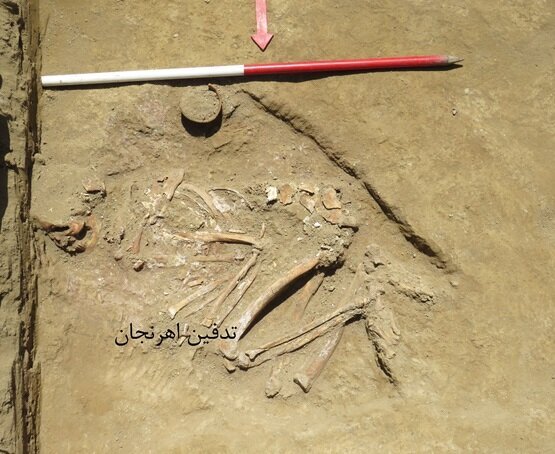Village dwellers buried dead beneath houses, archaeological evidence suggests

TEHRAN – A fresh archaeological evidence suggests that prehistorical residents of a northwestern Iranian village buried dead bodies beneath their houses.
A team of Iranian archaeologists has recently discovered four tomb chambers during excavations on Tepe Ahranjan in Salmas county, West Azarbaijan province, northwestern Iran.
The archaeological hill, according to previous excavations, is home to a 9,000-year-old human settlement. The tomb chambers date from the Neolithic and Chalcolithic periods, IRNA quoted Iranian archaeologist Afrasyab Geravand as saying on Saturday.
“The corpses were buried both individually and in one case as a mass (three burials) in oval and rectangular tombs,” he said.
In 2020, Geravand concluded that farming and animal breeding was practiced some 9,000 years ago around the historical Tepe Ahranjan. The discovery was made during a demarcation project aimed to protect the ruined archaeological site.
Evidence indicates Ahranjan hill and its surroundings were one of the first and most important human settlements in the 7th millennium BC in northwestern Iran, Geravand said.
The region has long been a suitable place for settlement since ancient times due to the presence of permanent rivers, springs, animal and plant resources, fertile land, and pastures, he explained.
Experts say the presence of “mother rocks” and obsidian tools in seven different colors, sabers, mortars, and stone utensils are among objects found in the region.
Experts say that by 7000 BC, sowing and harvesting reached Mesopotamia, and there, in the super fertile soil just north of the Persian Gulf, Sumerian ingenuity systematized it and scaled it up. By 6000 BC farming was entrenched on the banks of the Nile River. About this time, agriculture was developed independently in the Far East, probably in China, with rice rather than wheat as the primary crop.
Because of agriculture, cities, as well as trade relations between different regions and groups of people, developed, further enabling the advancement of human societies and cultures. Agriculture has been an important aspect of economics throughout the centuries before and after the Industrial Revolution. Sustainable development of world food supplies impacts the long-term survival of the species, so care must be taken to ensure that agricultural methods remain in harmony with the environment.
AFM
Leave a Comment